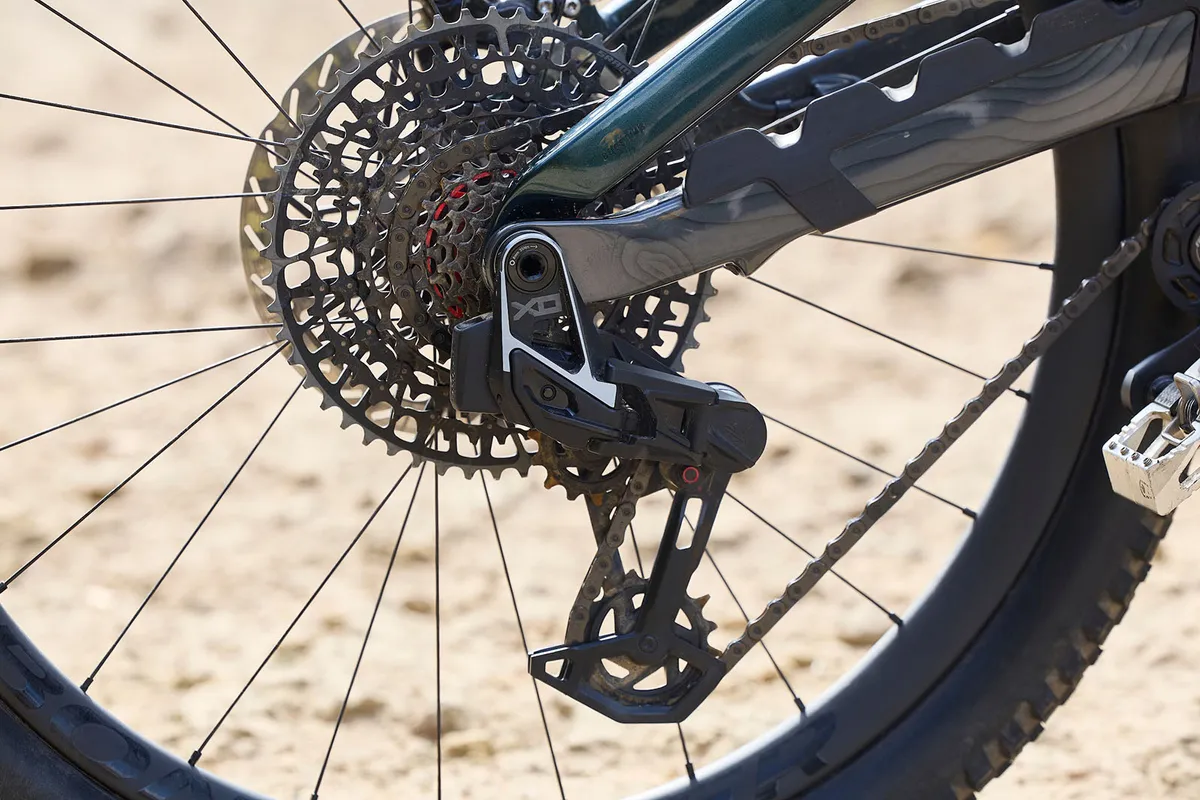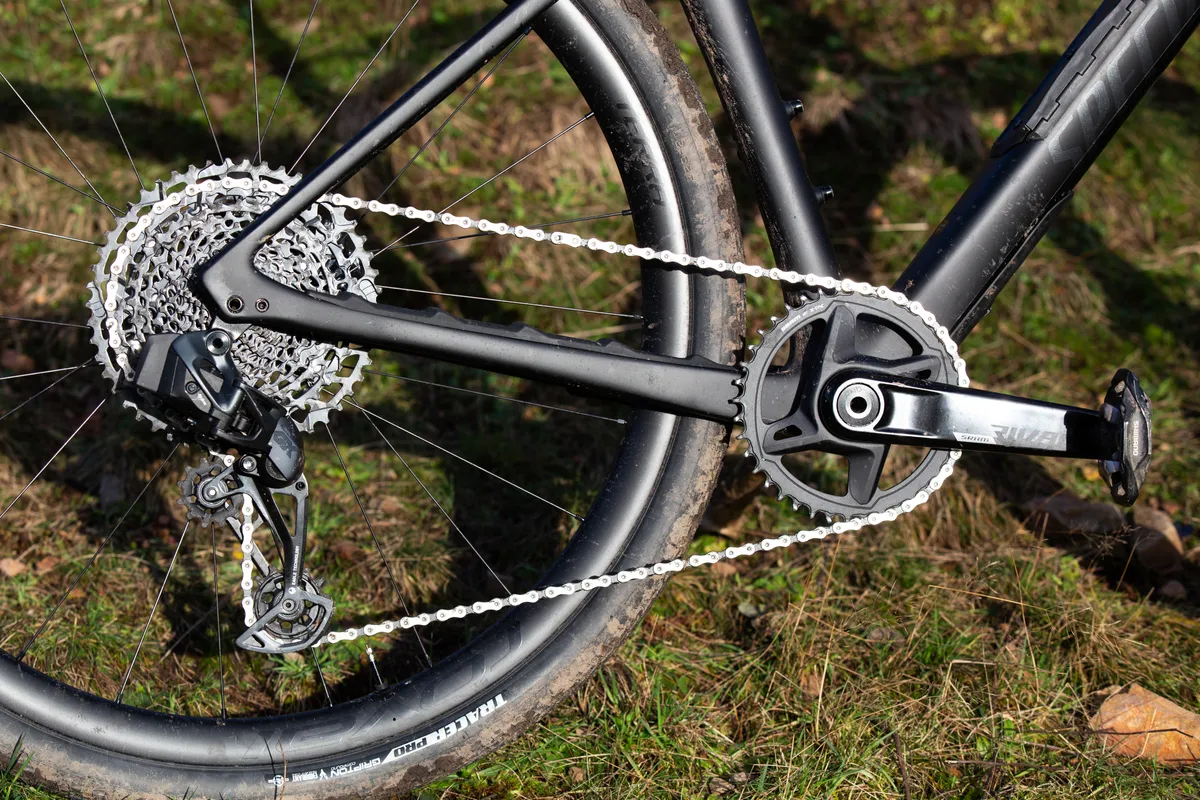A new 13-speed SRAM Red XPLR AXS groupset has been spotted at the 2024 Unbound gravel race.
When SRAM recently launched its flagship Red AXS groupset, a gravel variant was curiously omitted.
Now Red XPLR AXS is here – and it’s a radically different product from its road counterpart.
The new gravel groupset borrows from SRAM’s Transmission (what SRAM is officially referring to these components as, after initially being called T-Type) mountain bike groupsets, with the derailleur hanger incorporated into the rear derailleur itself, mounting directly onto a SRAM UDH (Universal Derailleur Hanger) dropout.
There are also some interesting features we didn’t expect, which may give a hint about how SRAM’s road and gravel groupsets will develop in the future.
Let’s take a look at the components.
A direct-mount rear derailleur

The new rear derailleur confirms it’s a Red XPLR AXS model because it says so on the component – there’s a ‘Red’ graphic on the main body and an ‘XPLR’ graphic on the derailleur cage by the lower pulley wheel.
Like Red AXS, the Red XPLR AXS rear derailleur features handsome polished sections and appears to be equipped with ceramic bearings.
The Red AXS rear derailleur relies on an Orbit Fluid damper, but the new derailleur appears to borrow the Overload clutch found on Transmission rear derailleurs.
The Overload clutch is focused more on protecting the derailleur’s shift motor to better protect the derailleur from damage.

Unlike the new Red AXS rear derailleur, which relies on a conventional derailleur hanger, this Red XPLR AXS derailleur mounts directly to the frame’s dropout.
This means the derailleur forgoes a conventional rear derailleur hanger and instead uses SRAM’s UDH standard.
Because of the UDH dropout, Transmission rear derailleurs lack limit and B-tension adjustment screws because the distance between the derailleur and cassette is controlled.
Instead, the derailleur is set up using SRAM’s AXS smartphone app or via buttons on the derailleur itself.

As a result of the rear derailleur lacking limit and B-tension screws, like Transmission, we suspect there will likely only be one cassette option.
In terms of ratios, the new 13-speed XPLR cassette could be a 10-48t, which would match Campagnolo Ekar GT.

By comparison, SRAM’s Transmission rear derailleurs are designed around a single 10-52t cassette. The road-oriented SRAM Red AXS rear derailleur can handle up to a largest 36t cog.
Although Shimano offers its mechanical GRX in a 10-51t flavour (this uses a Shimano XT M8100 cassette), we don’t think it would make sense for SRAM to manufacture a cassette that is only a single cog smaller than its 10-52t Transmission options.
Mountain bike uptake of the SRAM UDH dropout has been rapid and while it’s becoming more widespread on gravel bikes, there are many key models omitting the standard.
On the basis of this rear derailleur relying on the standard, surely most, if not all new gravel bike releases are going to adopt the UDH standard, especially because the standard also plays nicely with competitors’ rear derailleurs.
Shared shifters and brakes

Launched only a couple of weeks ago, SRAM Red AXS is the brand’s latest flagship road bike groupset, shaving 154g from its previous generation.
SRAM Red AXS incorporates a new lever and hood design, improved braking performance and design, and faster front shifting. Other than the price, senior technical editor Warren Rossiter found little to fault in his review.
From what we can deduce, SRAM Red AXS XPLR shares many of the same components as Red AXS. The shifters, brake calipers and disc brake rotors appear to be identical.
The shifter’s new hood shape is much lower in profile compared to the previous generation and 7mm longer in reach, too. The hydraulic piston has also been reoriented from its previous vertical alignment to a new horizontal layout to improve braking performance.
Crankset

The new crankset appears to be 1x only and the teeth are presumably oriented to mesh nicely with the chain.
Over the weekend at Unbound, we’ve seen a few riders using different crankset setups – Keegan Swenson’s Santa Cruz Stigmata had a 1x aero chainring with an integrated power meter, for example, while others were using the existing, 12-speed Red 1 crankset with a non-integrated power meter.
This suggests there may be some backwards compatibility between the new 13-speed components and existing 12-speed chainrings.
We’d nevertheless expect SRAM to release a new crankset with updated graphics and tooth profiles, though, as every new groupset needs a crankset, after all.
Chain and cassette – a sign of the future?

One of the most exciting aspects of SRAM’s latest Red AXS road groupset is its backwards compatibility. This means if you own a SRAM Apex, Rival or Force AXS groupset, you can upgrade to the new Red one piece at a time.
However, that doesn’t seem to be the case with SRAM Red AXS XPLR. Why? Because it’s 13-speed.
If you count the cassette cogs, there are 13 teeth. This is paired with a new 13-speed chain.
The shifters, brakes and crankset may be borrowed from SRAM’s flagship, 12-speed road groupset, but to upgrade here you’ll likely at least need the new Red XPLR AXS rear derailleur, cassette and chain.

Previously, all of SRAM’s performance-oriented road, gravel and mountain bike groupsets were 12-speed. This means they were all cross-compatible with one another, meaning, for example, you could pair road bike shifters with a mountain bike drivetrain.
It makes sense for SRAM to go to 13-speed because, until now, this has been a key selling point for one of its main rivals, Campagnolo. Both its Ekar and Ekar GT groupsets are 13-speed and the extra cog enables a more progressive jump between gears.
However, the downside is this means SRAM Red AXS XPLR will introduce more component incompatibilities – for example, you wouldn’t be able to use a Transmission 10-52t cassette with the new rear derailleur if you wanted a wider gear ratio because it’s 12-speed.
This could mean a wholesale move to 13-speed groupsets is coming from SRAM in the future. However, Transmission is only the best part of a year old (and the new 12-speed Red AXS is just under three weeks old) and it wouldn’t make sense for SRAM to supersede a product so soon into its lifecycle.
When will SRAM Red AXS XPLR be released?

The groupset looks to be a final production unit rather than a prototype because of the production graphics, so a launch may not be too far away.
However, it appears to be one of the first times the groupset has been used out in the wild and there may be a period of SRAM gathering feedback from its sponsored professional riders, to check the performance stands up to real-world use.
We’ve asked SRAM to comment and will update this article when we receive a response.

